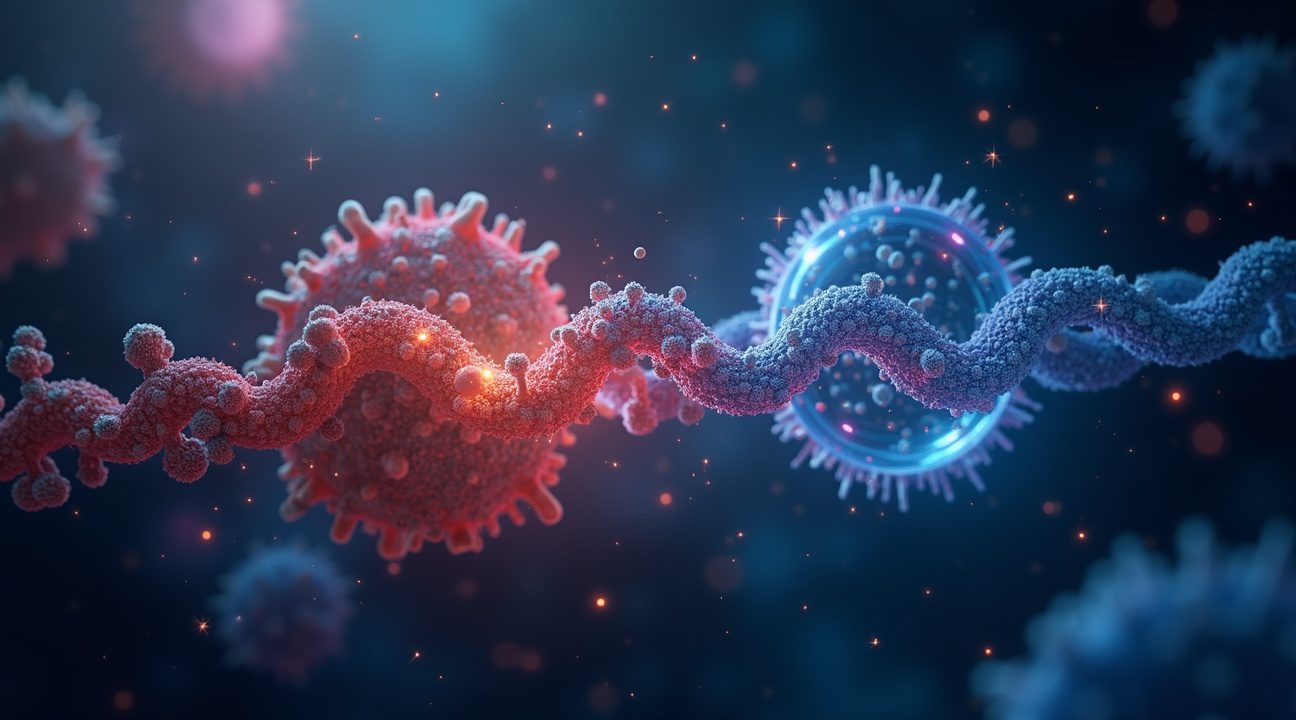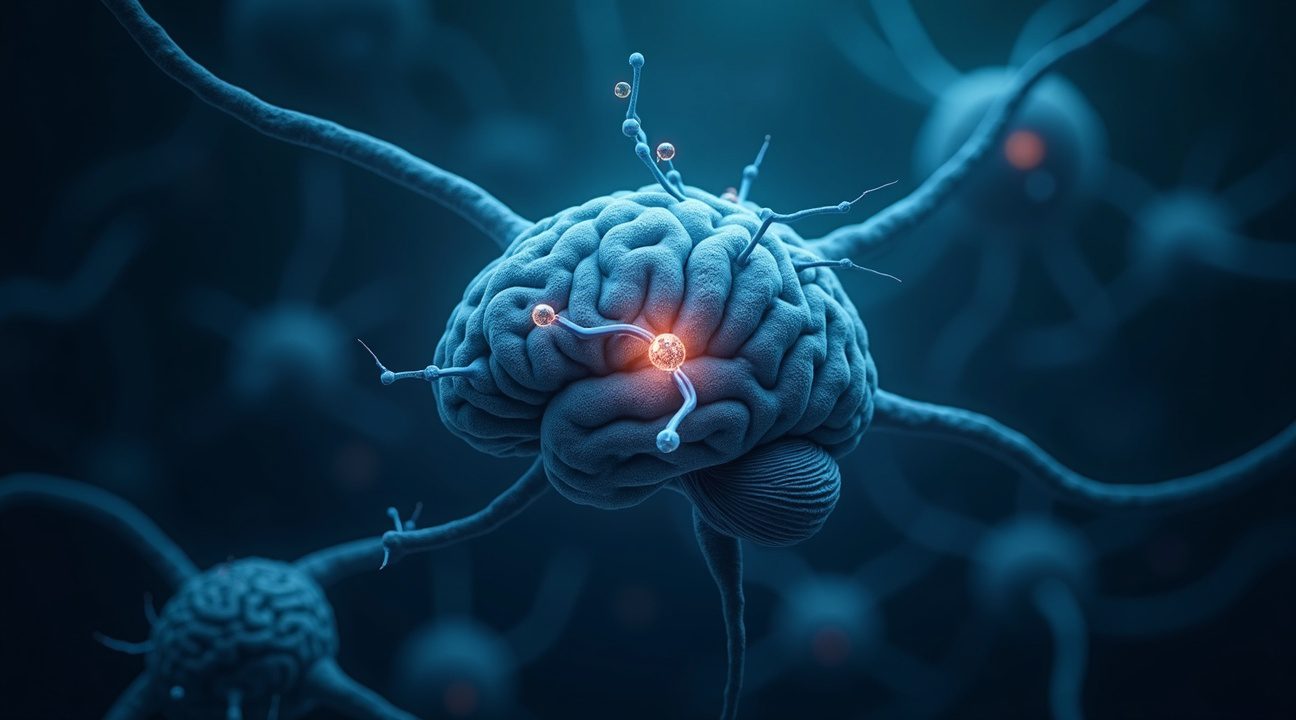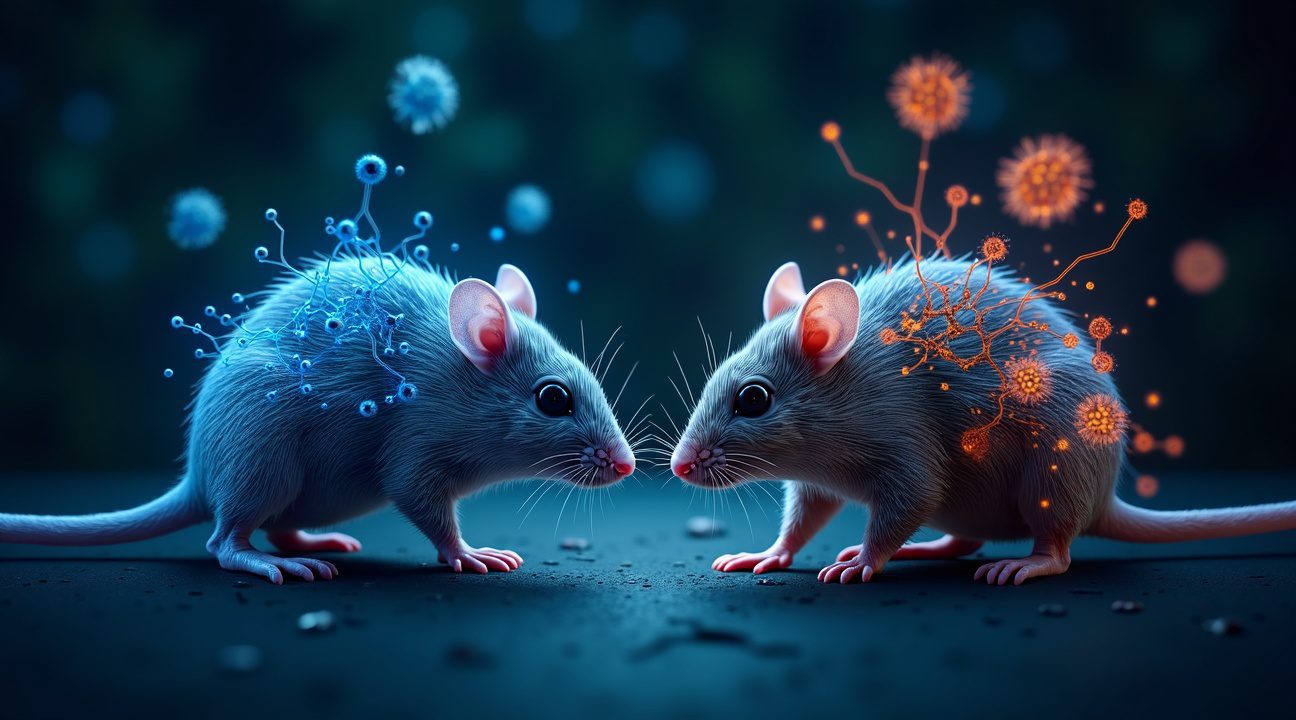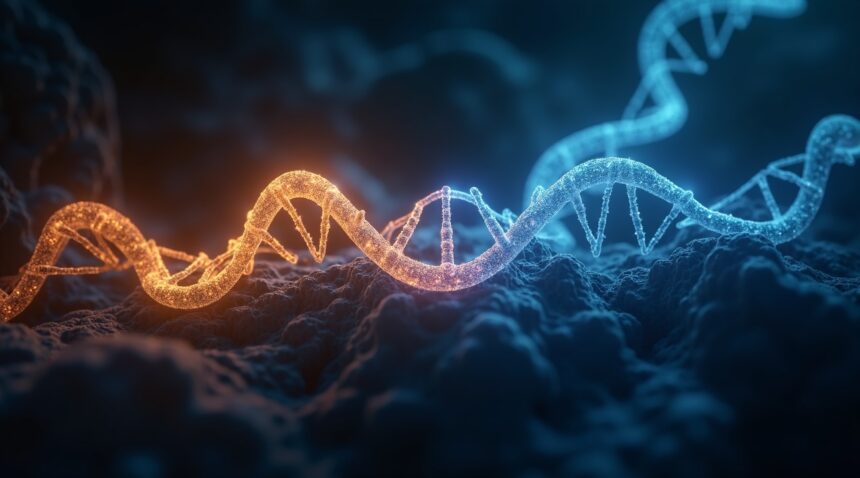Revolutionary Discovery: PDI’s New Role in DNA Repair and Healthy Aging
Scientists have uncovered that Protein Disulfide Isomerase (PDI), traditionally known for protein folding, transforms into a DNA repair enzyme that acts as cellular “glue” to fix double-strand breaks—the most dangerous form of genetic damage.
This discovery reveals PDI’s dual functionality as both a protein folder and DNA repair specialist, with particularly significant implications for preventing age-related neurodegeneration and extending healthy cellular lifespan.
Key Takeaways
- PDI can migrate from the endoplasmic reticulum to the nucleus where it repairs severe double-strand DNA breaks using its redox-dependent mechanisms.
- Brain cells are especially vulnerable to DNA damage accumulation since neurons don’t replicate throughout life, making PDI’s protective function critical for preventing cognitive decline.
- Daily cellular damage ranges from tens of thousands to over a million DNA lesions per cell, demanding constant repair to maintain cellular integrity and slow aging.
- Mouse studies demonstrate that enhanced DNA repair enzyme activity directly correlates with improved cognitive performance and cellular health.
- PDI is a promising therapeutic target for anti-aging medicine, with researchers exploring treatments to boost its activity and potentially extend healthy human lifespan.
Molecular Multitasker: PDI’s Dual Function
Researchers have made a groundbreaking discovery about an enzyme that could revolutionize our understanding of aging and cellular repair. PDI operates as a molecular multitasker, switching between protein folding duties in the endoplasmic reticulum and DNA repair work in the cell nucleus. This enzyme displays remarkable versatility by recognizing when cells need emergency DNA repair and migrating directly to damage sites.
DNA Damage: A Critical Cellular Threat
Double-strand DNA breaks pose the greatest threat to cellular integrity. Unlike single-strand breaks, which cells can repair relatively easily, double-strand breaks can trigger cell death or dangerous mutations if left unrepaired. PDI addresses this critical vulnerability by functioning as molecular glue that holds broken DNA pieces together while other repair mechanisms complete the healing process.
Neuronal Vulnerability and Cognitive Decline
The brain benefits most dramatically from PDI’s protective effects. Neurons face unique challenges because they don’t replicate throughout human life, making them particularly susceptible to accumulated DNA damage. Each brain cell must maintain its genetic integrity for decades without the opportunity to refresh through cell division. PDI’s ability to repair severe DNA damage becomes essential for preserving cognitive function as people age.
Daily Assault on DNA
Laboratory studies reveal the constant assault that cells endure from DNA damage. Environmental toxins, radiation, oxidative stress, and normal metabolic processes generate between 10,000 and 1,000,000 DNA lesions per cell per day. This relentless bombardment creates an ongoing repair crisis that determines how quickly cells age and lose function. PDI joins an army of repair enzymes working around the clock to maintain genetic stability.
Mouse Models Reveal Cognitive Benefits
Mouse experiments demonstrate PDI’s anti-aging potential through measurable improvements in cognitive performance. Animals with enhanced DNA repair enzyme activity show better memory, learning abilities, and overall brain health compared to control groups. These findings suggest that boosting PDI activity could translate into significant benefits for human brain aging.
Therapeutic Strategies to Enhance PDI Function
Scientists are now developing therapeutic strategies to enhance PDI function. Pharmaceutical researchers explore compounds that increase PDI expression, improve its DNA repair efficiency, or help it migrate more effectively to damage sites. Small molecule activators, gene therapy approaches, and lifestyle interventions all show promise for harnessing PDI’s anti-aging potential.
Redox Mechanisms and Lifestyle Support
The enzyme’s redox-dependent mechanisms offer another avenue for therapeutic intervention. PDI relies on specific oxidation-reduction reactions to perform its DNA repair functions. Maintaining optimal cellular redox balance through antioxidants, exercise, and dietary interventions could support PDI’s protective activities naturally.
Combating Age-Related Diseases
Age-related diseases often stem from accumulated DNA damage that overwhelms cellular repair capacity. Alzheimer’s disease, Parkinson’s disease, and other neurodegenerative conditions correlate with increased DNA damage in brain tissues. Enhancing PDI function could potentially delay or prevent these devastating conditions by maintaining genetic integrity in vulnerable neurons.
Future Research and Clinical Applications
Mechanisms of PDI Migration
Future research directions include identifying factors that regulate PDI’s migration between cellular compartments. Understanding how cells signal PDI to switch from protein folding to DNA repair could reveal new therapeutic targets. Scientists also investigate whether PDI activity declines with age and whether this decline contributes to increased DNA damage accumulation in older adults.
Toward Personalized Medicine
Clinical applications may emerge sooner than expected. Biomarkers of PDI activity could help physicians assess individual aging rates and DNA repair capacity. Personalized anti-aging treatments might target specific deficiencies in PDI function or related repair pathways. Blood tests measuring PDI levels or activity could guide preventive interventions before significant cellular damage accumulates.
Conclusion: A Central Player in Aging Research
The discovery positions PDI as a central player in healthy aging research. Its dual role in protein quality control and DNA repair makes it an attractive target for comprehensive anti-aging strategies. Interventions that boost PDI function could address multiple aspects of cellular deterioration simultaneously, offering more effective treatments than approaches targeting single aging mechanisms.
This breakthrough opens new possibilities for extending healthy human lifespan by addressing fundamental causes of cellular aging rather than just treating symptoms of age-related diseases.
Protein Disulfide Isomerase: The Cellular “Glue” That Could Transform Anti-Aging Medicine
Scientists have uncovered a remarkable cellular mechanism that challenges everything researchers thought they knew about aging. Protein Disulfide Isomerase (PDI), long recognized for its role in protein folding, has revealed a second identity as a DNA repair enzyme that literally acts as cellular “glue” for damaged genetic material.
From Protein Folder to DNA Repair Specialist
PDI traditionally operates in the endoplasmic reticulum, where it assists proteins in achieving their proper three-dimensional structures. However, recent discoveries show this versatile enzyme can migrate into the cell’s nucleus, where it takes on an entirely different function. Once inside the nucleus, PDI transforms into a sophisticated DNA repair specialist, targeting some of the most severe forms of genetic damage.
This dual functionality represents a significant breakthrough in cellular biology. PDI’s ability to switch roles demonstrates the intricate ways cells protect themselves from aging-related damage. The enzyme’s redox-dependent mechanism allows it to identify and repair compromised DNA structures with remarkable precision.
Targeting Double-Strand DNA Breaks
Double-strand DNA breaks represent one of the most dangerous forms of cellular damage. These severe lesions occur when both strands of the DNA helix suffer simultaneous breaks, creating potentially catastrophic disruptions to genetic information. Without proper repair, these breaks can lead to cell death or dangerous mutations.
PDI’s newly discovered role involves directly addressing these critical breaks through its unique redox biology capabilities. The enzyme essentially acts as molecular adhesive, helping to reconnect severed DNA strands and restore genetic integrity. This process requires precise coordination between PDI’s protein-folding expertise and its DNA repair functions.
Evidence suggests PDI’s DNA repair capabilities become particularly important in neurons, where cellular longevity is crucial for maintaining cognitive function. Neurons face constant oxidative stress and DNA damage throughout their extended lifespans. Research into brain function continues to reveal how cellular repair mechanisms impact neurological health.
Brain cells rely heavily on PDI to resolve DNA damage that would otherwise accumulate over time. This accumulation of unrepaired genetic lesions contributes significantly to cognitive decline and neurodegeneration. PDI’s intervention helps prevent this downward spiral by maintaining genetic stability in these critical cells.
The implications for anti-aging research are profound. Scientists now view PDI as a potential key player in developing strategies to combat cellular aging. Its ability to repair DNA damage while maintaining protein function positions it as a dual-action therapeutic target for longevity interventions.
Understanding PDI’s mechanisms opens new avenues for treating age-related diseases. Researchers are exploring ways to enhance PDI activity or develop synthetic compounds that mimic its DNA repair functions. These approaches could potentially slow cellular aging and extend healthy lifespan.
The discovery also highlights the interconnected nature of cellular repair systems. PDI’s dual role demonstrates how evolution has optimized cellular machinery for maximum efficiency. Single enzymes can serve multiple protective functions, creating redundant safety systems that help cells survive longer.
This finding connects to broader scientific efforts to understand aging mechanisms. Just as researchers explore possibilities like recreating ancient DNA, PDI research focuses on preserving and repairing existing genetic material to extend cellular lifespan.
Scientists continue investigating how PDI’s redox-dependent mechanisms might be enhanced or supplemented. The enzyme’s natural ability to switch between protein folding and DNA repair suggests cells have evolved sophisticated quality control systems. Understanding these systems could revolutionize approaches to treating age-related cellular damage and extending healthy human lifespan.

How Daily DNA Damage Overwhelms Our Cells and Accelerates Aging
I face a relentless assault on my cellular DNA every single day. Each cell in my body endures tens of thousands to over a million DNA lesions daily, creating a constant battle between damage and repair that ultimately determines how gracefully I age.
This damage comes from two primary sources: internal metabolic processes that generate harmful byproducts, and external environmental stressors including sunlight exposure and pollutants. The sheer volume is staggering – imagine trying to repair a house while it’s being continuously damaged by storms, and you’ll understand the challenge my cells face around the clock.
The Body’s DNA Repair Systems Work Overtime
Among all types of DNA damage, double-strand breaks (DSBs) represent the most serious threat to cellular survival. My body employs two main repair mechanisms to address these critical breaks:
- Non-homologous end joining (NHEJ) handles approximately 90% of DSBs in mammals.
- Homologous recombination (HR) resolves the remaining 10%.
NHEJ operates like an emergency repair crew – it’s fast and available at any time, but the quick fixes often introduce errors. HR functions more like precision craftsmen, delivering highly accurate repairs but only during specific phases of the cell cycle when the necessary molecular tools are available. This division of labor helps maintain cellular function, but both systems have limitations that become increasingly apparent with age.
Environmental factors continue to challenge these repair systems daily. Scientists studying cellular processes have found that the cumulative effect of damage often exceeds our natural repair capacity as we get older.
Unfortunately, repair efficiency declines drastically as I age. The molecular machinery responsible for fixing DNA damage becomes less effective, slower, and more prone to mistakes. This creates a dangerous cycle where accumulated damage impairs the very systems designed to prevent further deterioration.
The consequences extend far beyond simple cellular wear and tear. Impaired DNA repair contributes directly to aging through several mechanisms:
- Accumulation of harmful mutations that alter normal cell function
- Loss of essential cellular capabilities
- Activation of disease pathways that promote chronic and degenerative conditions
Research has shown that cellular mechanisms become increasingly compromised when DNA repair systems fail to keep pace with daily damage. This imbalance between damage and repair capacity explains why aging accelerates over time rather than proceeding at a steady rate.
The discovery of enzymes that can enhance DNA repair offers hope for addressing this fundamental aging process, potentially allowing cells to maintain their protective mechanisms longer and more effectively.
Why Brain Cells Are Most Vulnerable to Age-Related DNA Damage
Brain cells face a unique challenge that sets them apart from other cells in the human body. Unlike most cells that regularly divide and replace themselves, neurons don’t replicate throughout a person’s lifetime. This fundamental characteristic makes them extraordinarily vulnerable to accumulating DNA damage over decades of existence.
I’ve observed that this non-replicating nature means neurons can’t simply divide to create fresh, undamaged copies of themselves. Instead, they must rely on sophisticated repair mechanisms to maintain their genetic integrity. The protein disulfide isomerase (PDI) plays a critical role in this process by demonstrating an remarkable ability to enter the cell nucleus and directly repair damaged DNA strands.
The Declining Defense System
The protection that PDI provides doesn’t remain constant throughout life. As people age, I notice that PDI’s activity in DNA repair steadily diminishes, creating a cascade of problems for neuronal health. This decline accelerates neurodegeneration and significantly increases the risk of developing serious cognitive disorders.
The consequences manifest in several devastating conditions:
- Alzheimer’s disease, characterized by progressive memory loss and cognitive decline
- Parkinson’s disease, affecting movement and motor control
- Motor neuron disease, impacting nerve cells that control voluntary muscle movement
- Various other neurodegenerative conditions linked to DNA repair failures
Scientists have identified PDI’s catalytic cysteines as promising drug targets for therapeutic intervention. These specific molecular components represent potential entry points for medications designed to enhance the enzyme’s function. Enhanced PDI activity could theoretically slow the aging processes in neurons, offering hope for preventing or delaying the onset of age-related brain diseases.
Conversely, when PDI function becomes reduced, the correlation with rapid deterioration and earlier disease onset becomes apparent. This relationship highlights why brain research continues to focus on understanding these protective mechanisms.
The therapeutic implications extend beyond simple enzyme replacement. Researchers are exploring ways to boost PDI’s natural repair capabilities, potentially offering a preventive approach rather than merely treating symptoms after damage has occurred. This strategy could fundamentally change how medicine approaches age-related cognitive decline.
The vulnerability of brain cells to DNA damage represents one of the most significant challenges in aging research. Since neurons must last an entire lifetime without replacement, maintaining their genetic integrity becomes paramount for preserving cognitive function and preventing neurodegenerative diseases.

Experimental Evidence: What Mouse Studies Reveal About DNA Repair and Cognition
Laboratory research using mouse models provides compelling evidence for the connection between DNA repair enzymes and cognitive function. Scientists have observed that mice lacking specific DNA repair enzymes display increased levels of cellular damage throughout their neural tissue. These deficiencies correlate directly with measurable cognitive decline, including reduced memory formation and impaired learning abilities.
The relationship becomes even clearer when researchers introduce molecules that enhance enzyme activity. Mice treated with these activating compounds demonstrate improved DNA repair mechanisms alongside better cognitive performance. This bidirectional effect strengthens the argument that DNA repair enzymes function as critical protective agents for brain health.
Cellular Age and Repair Capacity
Senescent cells reveal a particularly striking pattern of DNA repair suppression. Research shows these aged cells experience widespread reduction in DNA repair gene expression, leaving them vulnerable to accumulating damage. The contrast with younger cellular populations is stark and measurable.
Laboratory experiments consistently demonstrate that aged cells struggle to recover from DNA-damaging treatments. While younger cells efficiently activate repair pathways and restore genomic integrity, their older counterparts show diminished responses to the same challenges. This reduced capacity appears across multiple cell types and aging models.
Comparative studies between senescent and quiescent cells highlight crucial differences in repair gene activity levels:
- Quiescent cells maintain their repair machinery in a ready state, allowing rapid responses to damage signals.
- Senescent cells show systematic downregulation of these protective pathways, leading to increased mutation rates and cellular dysfunction.
The experimental data reveals that DNA repair enzyme activity functions as a biological marker for cellular age and health status. Cells with robust repair systems maintain better function and resist age-related decline. Those with compromised repair mechanisms show accelerated deterioration and increased susceptibility to damage accumulation.
These findings parallel other groundbreaking discoveries in neuroscience that explore how cellular mechanisms influence brain function. The research establishes a clear mechanistic link between DNA repair capacity and cognitive health, providing a foundation for potential therapeutic interventions.
Mouse studies consistently show that maintaining active DNA repair systems protects against age-related cognitive decline. This protective effect extends beyond simple damage prevention to include preservation of neural plasticity and memory formation capabilities. The experimental evidence supports the concept that DNA repair enzymes act as fundamental guardians of cognitive function throughout the aging process.

From Laboratory to Medicine: PDI as the Next Anti-Aging Drug Target
PDI has emerged as a compelling drug target that could revolutionize how we approach healthy aging and longevity medicine. This enzyme’s ability to act as DNA glue makes it an attractive candidate for therapeutic interventions designed to enhance cellular repair mechanisms throughout the human body.
The pharmaceutical industry has recognized PDI’s potential for developing treatments that could significantly extend healthy human lifespan. Researchers are exploring various ways to activate this enzyme therapeutically, potentially offering a direct approach to strengthening our cells’ natural defense systems against age-related damage. This targeted strategy represents a shift from treating aging symptoms to addressing fundamental cellular breakdown processes.
Expanding Beyond Traditional Medicine
The cosmeceutical industry has shown considerable interest in harnessing PDI’s protective capabilities for advanced skincare formulations. Companies are developing products designed to shield DNA in skin cells from environmental damage, potentially slowing visible signs of aging at the cellular level. These innovative approaches could transform how we think about skincare, moving beyond surface-level treatments to address aging at its molecular foundation.
Scientists are simultaneously investigating chemical mixtures that rejuvenate cells by reducing harmful DNA modifications and effectively resetting cellular age. These compound-based therapies work differently from PDI activation but share the same goal of cellular renewal. The treatments could be customized based on specific cell types and optimal dosing protocols, opening new frontiers in precision medicine that account for individual genetic profiles and aging patterns.
Personalized anti-aging medicine represents one of the most exciting developments in this field. Different tissues may respond better to varying PDI activation levels, while some patients might benefit more from combination therapies that include both enzyme targeting and chemical rejuvenation approaches. This individualized strategy could maximize therapeutic benefits while minimizing potential risks, much like how researchers have approached understanding complex brain functions through detailed investigation.
The comparison between enzyme-targeting strategies like PDI activation and compound-based rejuvenation therapies reveals important considerations for treatment development.
Advantages of PDI Enhancement:
- Works with the body’s existing repair mechanisms
- Potentially reduces the risk of unexpected cellular responses
Considerations for Chemical Rejuvenation Approaches:
- May deliver more dramatic results in severely damaged cells
- Requires close monitoring to avoid overcorrection
Possible side effects present significant challenges that researchers must address before these treatments reach clinical application. Unwanted inflammation could occur if PDI activity becomes excessive, potentially causing more harm than benefit to healthy tissues. Similarly, overly aggressive repair activity might disrupt normal cellular functions or trigger unintended immune responses.
The balance between therapeutic benefit and potential risks requires extensive testing across different cell types and age groups. Scientists must determine optimal activation levels that enhance repair without overwhelming cellular systems. This delicate calibration process mirrors challenges faced in other cutting-edge research areas, from genetic reconstruction techniques to understanding life’s building blocks in extreme environments.
Clinical trials will need to evaluate both short-term and long-term effects of PDI-targeted therapies. Early studies suggest that controlled enzyme activation can improve cellular function without significant adverse effects, but larger populations and extended observation periods are necessary to confirm safety profiles. The complexity of these investigations parallels other ambitious scientific endeavors, including recent setbacks in space technology development that remind us of the careful progression required in breakthrough research.
As PDI moves from laboratory discovery to potential medical application, the integration of enzyme-targeting approaches with existing anti-aging strategies could create synergistic effects.
Potential Combination Strategies:
- PDI activation
- Lifestyle interventions (e.g., exercise, sleep optimization)
- Dietary modifications focused on cellular health
- Therapeutic compounds that enhance PDI or support DNA repair
This multi-pronged approach represents the future of anti-aging medicine, where understanding cellular repair mechanisms like PDI function guides comprehensive treatment protocols.
The Future of Longevity Research: Beyond PDI to Comprehensive Cellular Repair
The discovery of Protein Disulfide Isomerase (PDI) represents just the beginning of a revolutionary shift in how scientists approach cellular aging. This enzyme’s ability to repair double-strand DNA breaks opens doors to therapies that could fundamentally change aging intervention strategies. Beyond PDI, researchers are exploring comprehensive approaches that target multiple aspects of cellular deterioration simultaneously.
Expanding the Therapeutic Landscape
Current research extends far beyond single-enzyme therapies, encompassing redox biology, senescence pathways, and neurodegeneration mechanisms. Scientists are investigating how PDI interacts with other cellular repair systems to create synergistic effects. The focus has shifted to understanding how enzymes work together to maintain DNA integrity and prevent the accumulation of cellular damage that drives aging.
Personalized medicine approaches are gaining traction in this field, with researchers developing ways to tailor treatments based on individual genetic profiles and cellular repair capacities. This precision approach could maximize therapeutic benefits while minimizing potential side effects. The integration of advanced scientific discoveries continues to reveal new pathways for intervention.
Drug development programs are increasingly focusing on compounds that can enhance natural DNA repair mechanisms rather than simply replacing damaged components. These strategies aim to boost the body’s inherent ability to maintain cellular health throughout the aging process. Companies are investing heavily in research that combines PDI enhancement with other cellular repair mechanisms.
Clinical Translation and Safety Considerations
The path from laboratory discovery to clinical application requires careful attention to regulatory pathways and comprehensive safety profiles. Researchers must demonstrate that enhancing cellular repair mechanisms doesn’t inadvertently disrupt other essential biological processes. Early-stage clinical trials are beginning to test whether PDI-based therapies can safely improve cellular function in human subjects.
Cognitive preservation represents a particularly promising application area, as researchers explore how enhanced DNA repair might protect against age-related neurological decline. Studies are examining whether improved cellular repair mechanisms can maintain brain function and prevent neurodegenerative diseases. The potential for preserving mental acuity throughout extended lifespans makes this research especially compelling.
Comprehensive cellular repair strategies are emerging as a new pillar of longevity science, moving beyond single-target approaches to address multiple aging mechanisms simultaneously. These multi-faceted interventions could address the complex interplay of factors that contribute to cellular aging. The field is rapidly advancing toward treatments that enhance overall cellular resilience rather than targeting isolated problems.
Scientists are also exploring how environmental factors and lifestyle choices might influence the effectiveness of cellular repair therapies. This holistic approach recognizes that successful longevity interventions must work within the context of real-world conditions and individual health profiles. The goal is creating sustainable therapies that enhance quality of life while extending healthy lifespan.
The integration of artificial intelligence and advanced modeling techniques is accelerating the identification of new therapeutic targets beyond PDI. Machine learning algorithms are helping researchers predict which combinations of cellular repair mechanisms might work best together. This computational approach is streamlining the development process and reducing the time needed to bring new therapies to market.
Future research directions include investigating how cellular repair mechanisms change throughout different life stages and how treatments might be optimized for maximum effectiveness at specific ages. Scientists are also examining whether early intervention with cellular repair therapies could prevent age-related damage before it accumulates to problematic levels. These preventive approaches could represent the next major breakthrough in longevity science.

Sources:
New Atlas, “Anti-aging ‘glue’ naturally repairs damaged DNA to protect brain cells”
Cosmetics & Toiletries, “Could Targeting This Enzyme Slow Aging? Scientists Reveal PDI’s Role in DNA Repair”
MIT News, “Why too much DNA repair can injure tissue”
National Institutes of Health Common Fund, “Scientists Discover Possible Anti-Aging Treatment in Mouse Cells”
Nucleic Acids Research, “Broad repression of DNA repair genes in senescent cells identified”
Technology Networks, “Six Proteins Scientists Are Targeting To Slow Aging”
MIT Picower Institute, “Study finds aging neurons accumulate DNA damage”
PMC, “DNA-damage repair; the good, the bad, and the ugly”
Technology Networks, “Exploring DNA Damage and Repair Mechanisms: A Review with Lessons Learned from Plants”


